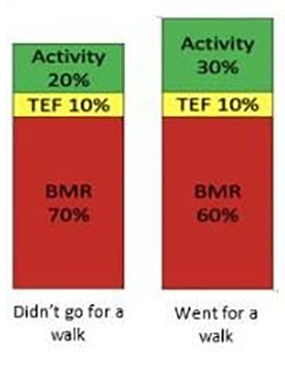Basal Metabolic Rate (BMR) a largely unmodified number that represents the amount of energy burned in a rested state.
Essentially, what it would take to keep you alive if you were to lie in bed completely sedentary with barely your vital functions working (e.g. a day in the life of quarantine).
BMR is tightly controlled by your body weight and will change depending on weight fluctuations over time (i.e. the bigger you are, the more energy it takes to maintain your weight and vice versa). So, unless we are making drastic changes to our body weight, this number won’t change a whole lot.
However, BMR is only a single part of the equation. Although it tends to make up 60-80% of our total daily energy expenditure, we also have our Activity (both exercise and non-exercise related), as well as the Thermic Effect of Food (TEF). 
Activity is the biggest modifiable factor to energy expenditure. Depending on how active you are during the day, it could vary from 15-30% of total energy spent. TEF is another modifiable factor, with certain food groups taking more energy to digest than others (protein has the highest TEF, fat the lowest).
With all this in mind, we should consider the easiest ways to increase our energy expenditure during this time. Pursuing a higher daily step count or participating in short workouts that get your heart rate up are two quick solutions to ensure we keep burning calories.
When it comes to meals, try to shoot for 2-3 servings of high-quality protein daily in order to make the most of TEF.
Consider the graph (pictured) as a representation of a day you were less active versus a day you were more active. The BMR remains the same in both, but by going for a simple walk, it is effectively giving you greater control over how much energy your body expends.
By Nick Naimo